A Stable Delivery System for Meretrix meretrix Derived Immunomodulatory Peptide (QLNWD): Fabrication and Characterization of Glycosylated Protein Nanoparticle
Abstract
1. Introduction
2. Results
2.1. Characterization of the BSA-DX Conjugates
2.2. Characteristics of GBA NPs
2.3. Characterization of GBA NPs Loading QLNWD
2.3.1. Particulate and Morphological Characteristics
2.3.2. Physicochemical Characterization
2.4. Evaluation of Physical Stability
2.5. In Vitro Release Profile and Bioaccessibility of QLNWD
2.6. Cytotoxicity Assessment
2.7. Cell Uptake Capacity
3. Discussion
4. Materials and Methods
4.1. Materials and Chemicals
4.2. Synthesis of BSA-DX Conjugates
4.3. Characterization of BSA-DX Conjugates
4.3.1. DG and Browning Index Measurement
4.3.2. SDS-PAGE
4.3.3. FT-IR
4.3.4. Fluorescence Spectroscopy
4.4. Preparation of Nanoparticle
4.5. Preparation of QLNWD-Loaded GBA NPs
4.6. EE of QLNWD
4.7. Characterization of NPs
4.7.1. Determination of Particle Size, Zeta Potential, and Turbidity
4.7.2. Morphological Characterization
4.7.3. FT-IR and XRD
4.7.4. DSC
4.8. Stability of the Delivery System
4.8.1. Storage Stability
4.8.2. pH Stability
4.8.3. In Vitro Release Study of QLNWD in NPs
4.8.4. Bioaccessibility Evaluation of QLNWD
4.9. Cell Viability
4.10. Cell Uptake
4.11. Statistical Analysis
5. Conclusions
Author Contributions
Funding
Institutional Review Board Statement
Data Availability Statement
Conflicts of Interest
Abbreviations
| BSA | Bovine serum albumin |
| CCK-8 | Cell Counting Kit-8 |
| CLSM | Confocal laser scanning microscope |
| DG | Degree of glycosylation |
| DLS | Dynamic light scattering |
| DX | Dextran |
| EE | Encapsulation efficiency |
| FT-IR | Fourier transform-infrared spectroscopy |
| GBA NPs | Glycosylated BSA nanoparticles |
| PBS | Phosphate-buffer solution |
| PDI | Polydispersity index |
| QLNWD | Gln-Leu-Asn-Trp-Asp |
| R | Pearson’s correlation coefficient |
| RhB | Rhodamine B |
| SDS-PAGE | Sodium dodecyl sulfate-polyacrylamide gel electrophoresis |
| SGF | Simulated gastric fluid |
| SIF | Simulated intestinal fluid |
| TEM | Transmission electron microscopy |
| Tm | Melting temperature |
| XRD | X-ray diffraction |
References
- Shahidi, F.; Saeid, A. Bioactivity of Marine-Derived Peptides and Proteins: A Review. Mar. Drugs 2025, 23, 157. [Google Scholar] [CrossRef] [PubMed]
- Sridhar, K.; Inbaraj, B.S.; Chen, B.-H. Recent Developments on Production, Purification and Biological Activity of Marine Peptides. Food Res. Int. 2021, 147, 110468. [Google Scholar] [CrossRef] [PubMed]
- Guryanova, S.V.; Ovchinnikova, T.V. Multifaceted Marine Peptides and Their Therapeutic Potential. Mar. Drugs 2025, 23, 288. [Google Scholar] [CrossRef]
- Zhang, W.; Ye, L.; Wang, F.; Zheng, J.; Tian, X.; Chen, Y.; Ding, G.; Yang, Z. Immunomodulatory Effects of the Meretrix Meretrix Oligopeptide (QLNWD) on Immune-Deficient Mice. Molecules 2019, 24, 4452. [Google Scholar] [CrossRef]
- Zhu, Q.; Chen, Z.; Paul, P.K.; Lu, Y.; Wu, W.; Qi, J. Oral Delivery of Proteins and Peptides: Challenges, Status Quo and Future Perspectives. Acta Pharm. Sin. B 2021, 11, 2416–2448. [Google Scholar] [CrossRef]
- Xu, C.; Liu, Y.; Li, K.; Zhang, J.; Wei, B.; Wang, H. Absorption of Food-Derived Peptides: Mechanisms, Influencing Factors, and Enhancement Strategies. Food Res. Int. 2024, 197, 115190. [Google Scholar] [CrossRef]
- Sharma, R.; Borah, S.J.; Bhawna; Kumar, S.; Gupta, A.; Singh, P.; Goel, V.K.; Kumar, R.; Kumar, V. Functionalized Peptide-Based Nanoparticles for Targeted Cancer Nanotherapeutics: A State-of-the-Art Review. ACS Omega 2022, 7, 36092–36107. [Google Scholar] [CrossRef]
- Cheng, K.; Ding, Y.; Zhao, Y.; Ye, S.; Zhao, X.; Zhang, Y.; Ji, T.; Wu, H.; Wang, B.; Anderson, G.J.; et al. Sequentially Responsive Therapeutic Peptide Assembling Nanoparticles for Dual-Targeted Cancer Immunotherapy. Nano Lett. 2018, 18, 3250–3258. [Google Scholar] [CrossRef]
- Gallo, E.; Diaferia, C.; Smaldone, G.; Rosa, E.; Pecoraro, G.; Morelli, G.; Accardo, A. Fmoc-FF Hydrogels and Nanogels for Improved and Selective Delivery of Dexamethasone in Leukemic Cells and Diagnostic Applications. Sci. Rep. 2024, 14, 9940. [Google Scholar] [CrossRef]
- Atma, Y.; Murray, B.S.; Sadeghpour, A.; Goycoolea, F.M. Encapsulation of Short-Chain Bioactive Peptides (BAPs) for Gastrointestinal Delivery: A Review. Food Funct. 2024, 15, 3959–3979. [Google Scholar] [CrossRef]
- Liang, S.; Zhao, D.; Liu, X.; Liu, B.; Li, Y. The Stomach, Small Intestine, and Colon-Specific Gastrointestinal Tract Delivery Systems for Bioactive Nutrients. Adv. Colloid Interface Sci. 2025, 341, 103503. [Google Scholar] [CrossRef]
- Wei, Z.; Huang, Q. Assembly of Protein–Polysaccharide Complexes for Delivery of Bioactive Ingredients: A Perspective Paper. J. Agric. Food Chem. 2019, 67, 1344–1352. [Google Scholar] [CrossRef]
- Nooshkam, M.; Varidi, M. Maillard Conjugate-Based Delivery Systems for the Encapsulation, Protection, and Controlled Release of Nutraceuticals and Food Bioactive Ingredients: A Review. Food Hydrocoll. 2020, 100, 105389. [Google Scholar] [CrossRef]
- Tanidjaja, I.; Damodaran, S. Influence of Amino Acids on Thermal Stability and Heat-Set Gelation of Bovine Serum Albumin. Food Chem. 2021, 337, 127670. [Google Scholar] [CrossRef]
- Chen, Y.; Wang, J.; Xu, J.; Zhang, J.; Xu, S.; Zhang, Q.; Huang, J.; Peng, J.; Xu, H.; Du, Q.; et al. Fabrication of a Polysaccharide-Protein/Protein Complex Stabilized Oral Nanoemulsion to Facilitate the Therapeutic Effects of 1,8-Cineole on Atherosclerosis. ACS Nano 2023, 17, 9090–9109. [Google Scholar] [CrossRef] [PubMed]
- Muhoza, B.; Xia, S.; Cai, J.; Zhang, X.; Su, J.; Li, L. Time Effect on Coenzyme Q10 Loading and Stability of Micelles Based on Glycosylated Casein via Maillard Reaction. Food Hydrocoll. 2017, 72, 271–280. [Google Scholar] [CrossRef]
- Feng, J.; Wu, S.; Wang, H.; Liu, S. Improved Bioavailability of Curcumin in Ovalbumin-Dextran Nanogels Prepared by Maillard Reaction. J. Funct. Foods 2016, 27, 55–68. [Google Scholar] [CrossRef]
- Chen, H.; Yang, J.; Liu, Z.; Li, Y.; Tang, Z.; Shi, X.; Chen, Q. Fault-tolerant and On-demand Supra Tough Adhesive Natural Albumin-based Organohydrogels. Adv. Funct. Mater. 2025, 35, 2413171. [Google Scholar] [CrossRef]
- Xie, H.; Xiang, C.; Li, Y.; Wang, L.; Zhang, Y.; Song, Z.; Ma, X.; Lu, X.; Lei, Q.; Fang, W. Fabrication of Ovalbumin/κ-Carrageenan Complex Nanoparticles as a Novel Carrier for Curcumin Delivery. Food Hydrocoll. 2019, 89, 111–121. [Google Scholar] [CrossRef]
- Feng, J.-L.; Qi, J.-R.; Yin, S.-W.; Wang, J.-M.; Guo, J.; Weng, J.-Y.; Liu, Q.-R.; Yang, X.-Q. Fabrication and Characterization of Stable Soy β-Conglycinin–Dextran Core–Shell Nanogels Prepared via a Self-Assembly Approach at the Isoelectric Point. J. Agric. Food Chem. 2015, 63, 6075–6083. [Google Scholar] [CrossRef]
- Huang, F.; Wang, J.; Yu, F.; Tang, Y.; Ding, G.; Yang, Z.; Sun, Y. Protective Effect of Meretrix Meretrix Oligopeptides on High-Fat-Diet-Induced Non-Alcoholic Fatty Liver Disease in Mice. Mar. Drugs 2018, 16, 39. [Google Scholar] [CrossRef]
- Fan, Y.; Yi, J.; Zhang, Y.; Yokoyama, W. Fabrication of Curcumin-Loaded Bovine Serum Albumin (BSA)-Dextran Nanoparticles and the Cellular Antioxidant Activity. Food Chem. 2018, 239, 1210–1218. [Google Scholar] [CrossRef]
- Feng, J.; Wu, Y.; Zhang, L.; Li, Y.; Liu, S.; Wang, H.; Li, C. Enhanced Chemical Stability, Intestinal Absorption, and Intracellular Antioxidant Activity of Cyanidin-3-O-Glucoside by Composite Nanogel Encapsulation. J. Agric. Food Chem. 2019, 67, 10432–10447. [Google Scholar] [CrossRef]
- Li, D.; Wei, Z.; Sun, J.; Xue, C. Tremella Polysaccharides-Coated Zein Nanoparticles for Enhancing Stability and Bioaccessibility of Curcumin. Curr. Res. Food Sci. 2022, 5, 611–618. [Google Scholar] [CrossRef]
- Zhu, Y.; Sun, X.; Luo, X.; Ding, J.; Fan, F.; Li, P.; Shen, X.; Fang, Y. Encapsulation of Selenium-Containing Peptides in Xanthan Gum-Lysozyme Nanoparticles as a Powerful Gastrointestinal Delivery System. Food Res. Int. 2022, 156, 111351. [Google Scholar] [CrossRef]
- Yang, M.; Liu, J.; Li, Y.; Yang, Q.; Liu, C.; Liu, X.; Zhang, B.; Zhang, H.; Zhang, T.; Du, Z. Co-Encapsulation of Egg-White-Derived Peptides (EWDP) and Curcumin within the Polysaccharide-Based Amphiphilic Nanoparticles for Promising Oral Bioavailability Enhancement: Role of EWDP. J. Agric. Food Chem. 2022, 70, 5126–5136. [Google Scholar] [CrossRef] [PubMed]
- Li, Y.; Liu, J.; Shi, X.; Zhang, H.; Zhang, L.; Xu, Z.; Zhang, T.; Yu, Y.; Du, Z. Precursor Template-Induced Egg White-Derived Peptides Self-Assembly for the Enhancement of Curcumin: Structure, Environmental Stability, and Bioavailability. Food Res. Int. 2023, 172, 113120. [Google Scholar] [CrossRef] [PubMed]
- Tian, L.; Zhao, Y.; Pan, F.; Ren, W.; Yang, M.; Li, Y.; Li, S.; Yu, Y.; Zhang, T.; Du, Z. Supramolecular Protein-Peptide Co-Assembly Mediated by Ca2+ Enhances Curcumin Penetration through Intestinal Barriers. Food Hydrocoll. 2025, 169, 111581. [Google Scholar] [CrossRef]
- Li, Y.; Liu, J.; Zhang, H.; Shi, X.; Li, S.; Yang, M.; Zhang, T.; Xiao, H.; Du, Z. A Comprehensive Review of Self-Assembled Food Protein-Derived Multicomponent Peptides: From Forming Mechanism and Structural Diversity to Applications. J. Agric. Food Chem. 2023, 71, 11304–11319. [Google Scholar] [CrossRef]
- Qi, J.; Yao, P.; He, F.; Yu, C.; Huang, C. Nanoparticles with Dextran/Chitosan Shell and BSA/Chitosan Core—Doxorubicin Loading and Delivery. Int. J. Pharm. 2010, 393, 177–185. [Google Scholar] [CrossRef]
- Wu, C.; Xiang, S.; Wang, H.; Zhang, X.; Tian, X.; Tan, M.; Su, W. Orally Deliverable Sequence-Targeted Fucoxanthin-Loaded Biomimetic Extracellular Vesicles for Alleviation of Nonalcoholic Fatty Liver Disease. ACS Appl. Mater. Interfaces 2024, 16, 9854–9867. [Google Scholar] [CrossRef]
- Yang, M.; Liu, J.; Li, Y.; Yang, Q.; Liu, X.; Liu, C.; Ma, S.; Liu, B.; Zhang, T.; Xiao, H.; et al. A Self-Assembled Amphiphilic Polysaccharide-Based Co-Delivery System for Egg White Derived Peptides and Curcumin with Oral Bioavailability Enhancement. Food Funct. 2021, 12, 10512–10523. [Google Scholar] [CrossRef]
- Li, Z.; Wang, Y.; Song, B.; Li, J.; Bao, Y.; Jiang, Q.; Chen, Y.; Yang, S.; Yang, Y.; Tian, J.; et al. The Comparison between Zein-Anthocyanins Complex and Nanoparticle Systems: Stability Enhancement, Interaction Mechanism, and in Silico Approaches. Food Chem. 2023, 420, 136136. [Google Scholar] [CrossRef] [PubMed]
- Deng, W.; Li, J.; Yao, P.; He, F.; Huang, C. Green Preparation Process, Characterization and Antitumor Effects of Doxorubicin-BSA-Dextran Nanoparticles. Macromol. Biosci. 2010, 10, 1224–1234. [Google Scholar] [CrossRef] [PubMed]
- Chen, F.-P.; Ou, S.-Y.; Tang, C.-H. Core–Shell Soy Protein–Soy Polysaccharide Complex (Nano)Particles as Carriers for Improved Stability and Sustained Release of Curcumin. J. Agric. Food Chem. 2016, 64, 5053–5059. [Google Scholar] [CrossRef]
- Davidov-Pardo, G.; Joye, I.J.; Espinal-Ruiz, M.; McClements, D.J. Effect of Maillard Conjugates on the Physical Stability of Zein Nanoparticles Prepared by Liquid Antisolvent Coprecipitation. J. Agric. Food Chem. 2015, 63, 8510–8518. [Google Scholar] [CrossRef] [PubMed]
- Yu, Z.; Gao, Y.; Shang, Z.; Wang, T.; He, X.; Lei, J.; Tai, F.; Zhang, L.; Chen, Y. A Stable Delivery System for Curcumin: Fabrication and Characterization of Self-Assembling Acylated Kidney Bean Protein Isolate Nanogels. Food Chem. 2024, 443, 138526. [Google Scholar] [CrossRef]
- Cummings, R.D. The Mannose Receptor Ligands and the Macrophage Glycome. Curr. Opin. Struct. Biol. 2022, 75, 102394. [Google Scholar] [CrossRef]
- Du, J.; Hong, Y.; Cheng, L.; Gu, Z. Fabrication of Starch-Based Nanoparticles to Enhance the Stability and in Vivo Release of Insulin. Int. J. Biol. Macromol. 2025, 308, 142393. [Google Scholar] [CrossRef]
- Zhou, Y.; Jiang, Y.; Zhang, Y.; Yokoyama, W.; Wu, J.; Chang, S.K.C.; Hong, H.; Luo, Y.; Li, B.; Tan, Y. Unveiling a New Chapter for Collagen Peptides: Comprehensive Insights into Oral Bioavailability and the Enhancement via Encapsulation Systems. Trends Food Sci. Technol. 2025, 156, 104849. [Google Scholar] [CrossRef]
- Li, Y.; Liu, J.; Shi, X.; Li, S.; Zhang, H.; Zhang, L.; Huang, X.; Liu, S.; Wang, W.; Tian, L.; et al. Casein-Quaternary Chitosan Complexes Induced the Soft Assembly of Egg White Peptide and Curcumin for Ulcerative Colitis Alleviation. Int. J. Biol. Macromol. 2024, 269, 132107. [Google Scholar] [CrossRef] [PubMed]
- Yang, K.; Han, H.S.; An, S.H.; Park, K.H.; Nam, K.; Hwang, S.; Lee, Y.; Cho, S.Y.; Kim, T.; Choe, D.; et al. Mucoadhesive Chitosan Microcapsules for Controlled Gastrointestinal Delivery and Oral Bioavailability Enhancement of Low Molecular Weight Peptides. J. Control. Release 2024, 365, 422–434. [Google Scholar] [CrossRef] [PubMed]
- Yang, M.; Liu, J.; Liu, C.; Zhang, H.; Li, S.; Zhang, T.; Yu, Z.; Chi, X.; Zhang, Z.; Du, Z. Programmable Food-Derived Peptide Coassembly Strategies for Boosting Targeted Colitis Therapy by Enhancing Oral Bioavailability and Restoring Gut Microenvironment Homeostasis. ACS Nano 2025, 19, 600–620. [Google Scholar] [CrossRef] [PubMed]
- Sheng, L.; Tang, G.; Wang, Q.; Zou, J.; Ma, M.; Huang, X. Molecular Characteristics and Foaming Properties of Ovalbumin-Pullulan Conjugates through the Maillard Reaction. Food Hydrocoll. 2020, 100, 105384. [Google Scholar] [CrossRef]
- Li, Z.; Jiang, H.; Guo, M.; Zhang, Z.; You, X.; Wang, X.; Ma, M.; Zhang, X.; Wang, C. Effect of Various Oligosaccharides on Casein Solubility and Other Functional Properties: Via Maillard Reaction. Int. J. Biol. Macromol. 2024, 259, 129148. [Google Scholar] [CrossRef]
- Chen, Y.; Tie, S.; Zhang, X.; Zhang, L.; Tan, M. Preparation and Characterization of Glycosylated Protein Nanoparticles for Astaxanthin Mitochondria Targeting Delivery. Food Funct. 2021, 12, 7718–7727. [Google Scholar] [CrossRef]
- Zeng, Q.; Zeng, W.; Jin, Y.; Sheng, L. Construction and Evaluation of Ovalbumin-Pullulan Nanogels as a Potential Delivery Carrier for Curcumin. Food Chem. 2022, 367, 130716. [Google Scholar] [CrossRef]
- Zhang, Z.; Ge, M.; Wu, D.; Li, W.; Chen, W.; Liu, P.; Zhang, H.; Yang, Y. Resveratrol-Loaded Sulfated Hericium Erinaceus β-Glucan-Chitosan Nanoparticles: Preparation, Characterization and Synergistic Anti-Inflammatory Effects. Carbohydr. Polym. 2024, 332, 121916. [Google Scholar] [CrossRef]
- Du, Z.; Liu, J.; Zhang, H.; Chen, Y.; Wu, X.; Zhang, Y.; Li, X.; Zhang, T.; Xiao, H.; Liu, B. l-Arginine/l-Lysine Functionalized Chitosan–Casein Core–Shell and pH-Responsive Nanoparticles: Fabrication, Characterization and Bioavailability Enhancement of Hydrophobic and Hydrophilic Bioactive Compounds. Food Funct. 2020, 11, 4638–4647. [Google Scholar] [CrossRef]
- Li, Z.; Wang, S.; Abou-Elsoud, M.; Li, Y.; Wang, H.; Liu, M.; Hu, W.; Ahn, D.U.; Huang, X. Simulated Gastrointestinal Digestion Enhances the Immunomodulatory Activity of Ovalbumin Peptide NVMEERKIK: Mechanistic Insights into TLR4/MAPK/NF-κB Signaling Modulation. J. Agric. Food Chem. 2025, 73, 9650–9661. [Google Scholar] [CrossRef]
- Wang, Z.; Fu, S.; Han, Y.; Wang, J.; Cao, J.; Wang, J.; Zhang, Z.; Yang, X. Ternary Composite Nanoparticles to Improve the Water Solubility and Stability of Resveratrol:Preparation, Characterization and Bioavailability. Food Chem. 2025, 474, 143258. [Google Scholar] [CrossRef]
- Huang, J.; Li, X.; Zhao, H.; Li, H.; Kuang, J.; Li, J.; Guo, J.; Huang, T.; Li, J. Construction of Faba Bean Protein Isolate Delivery Vector Based on pH-Driven Technology: Formation Mechanism, Structural Characterization, and Delivery Potential. Food Hydrocoll. 2025, 166, 111351. [Google Scholar] [CrossRef]



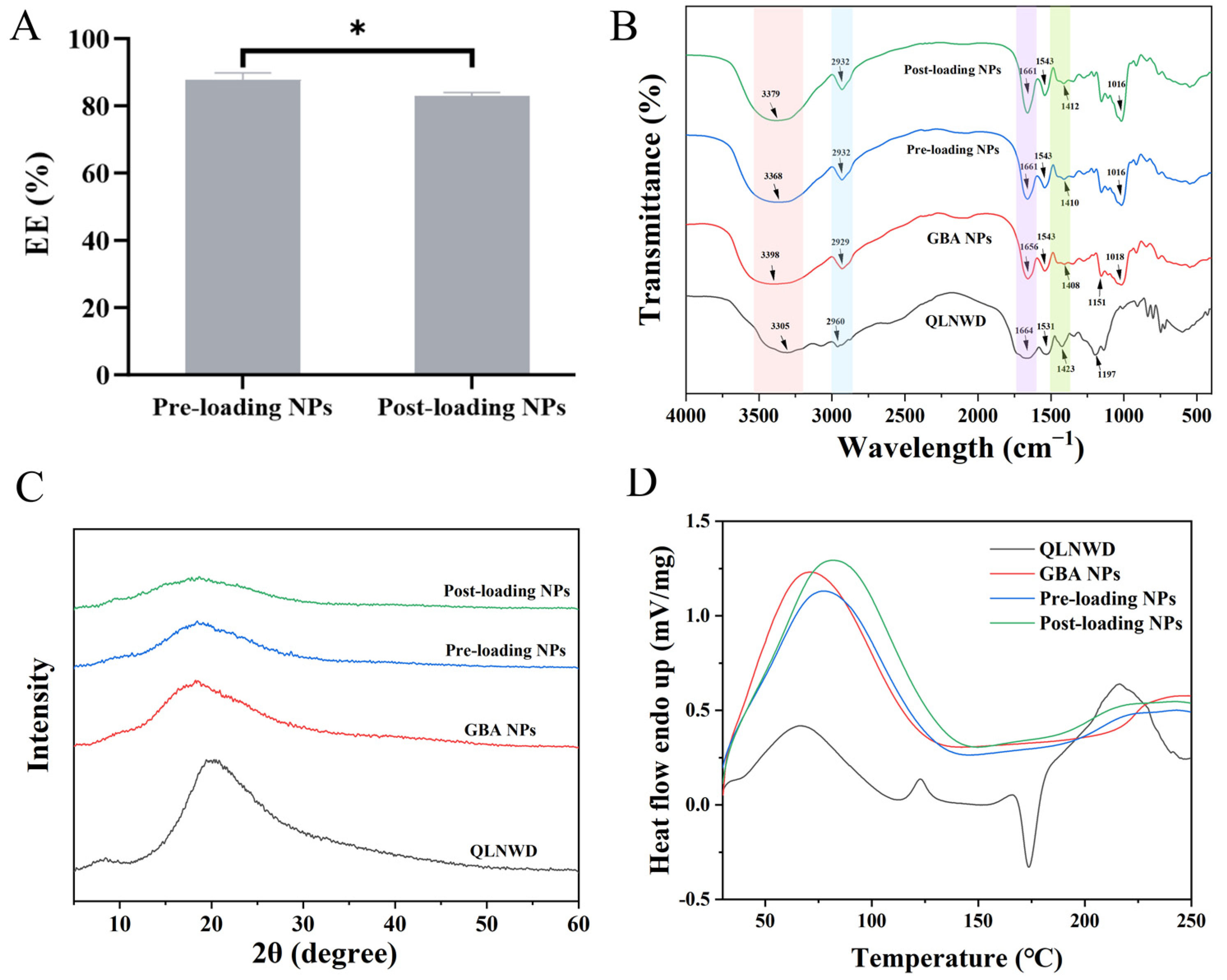
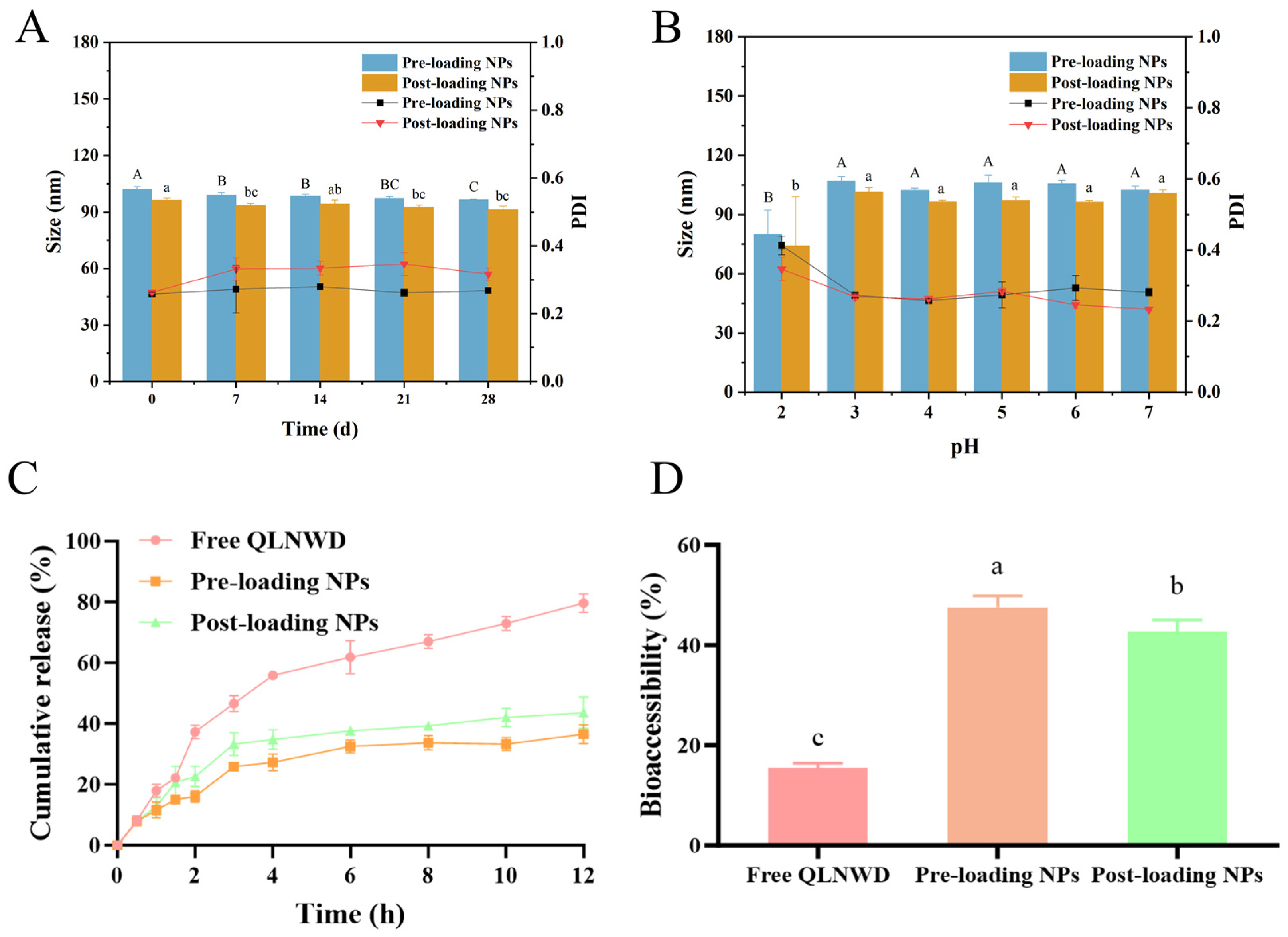
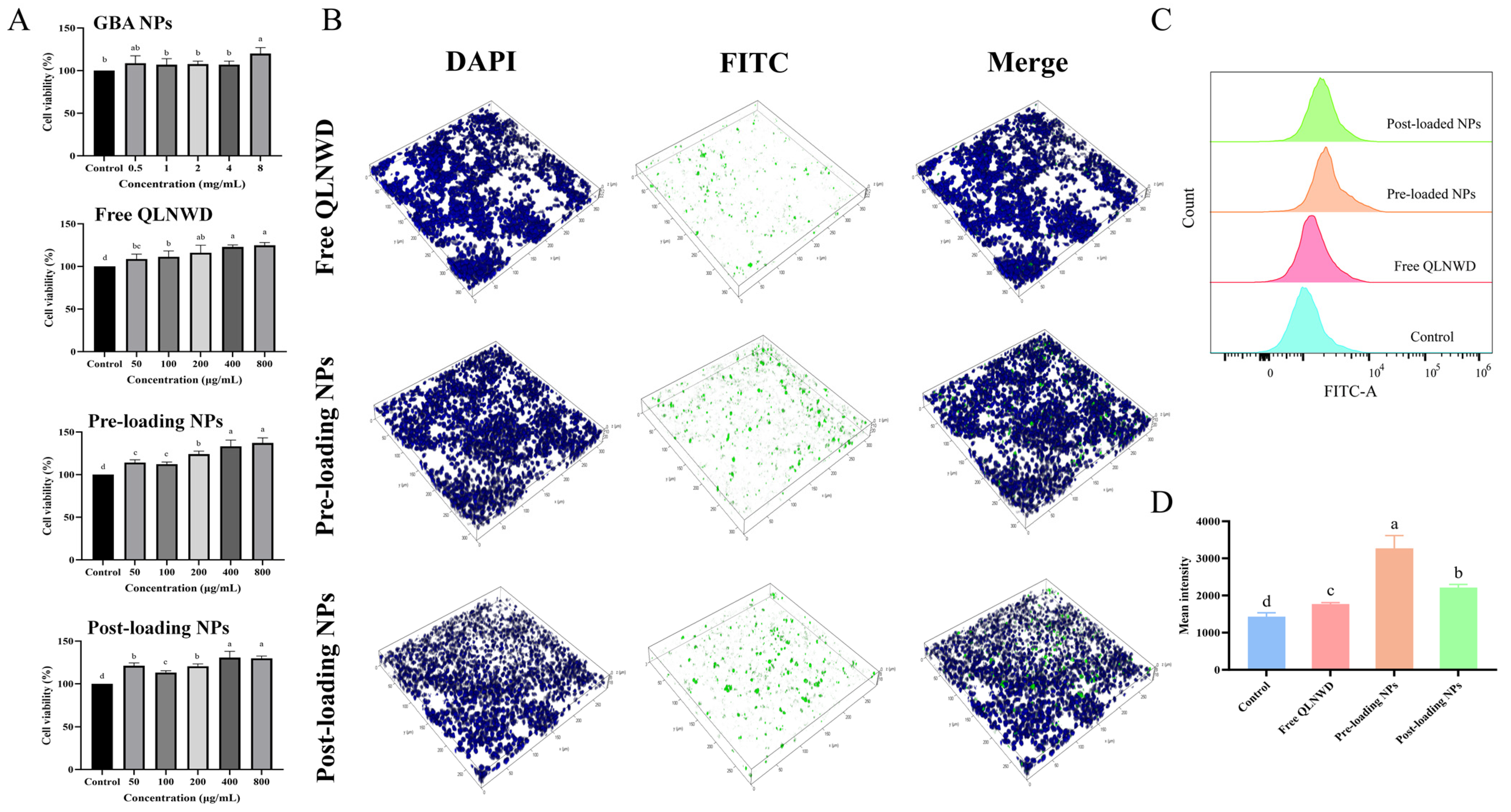
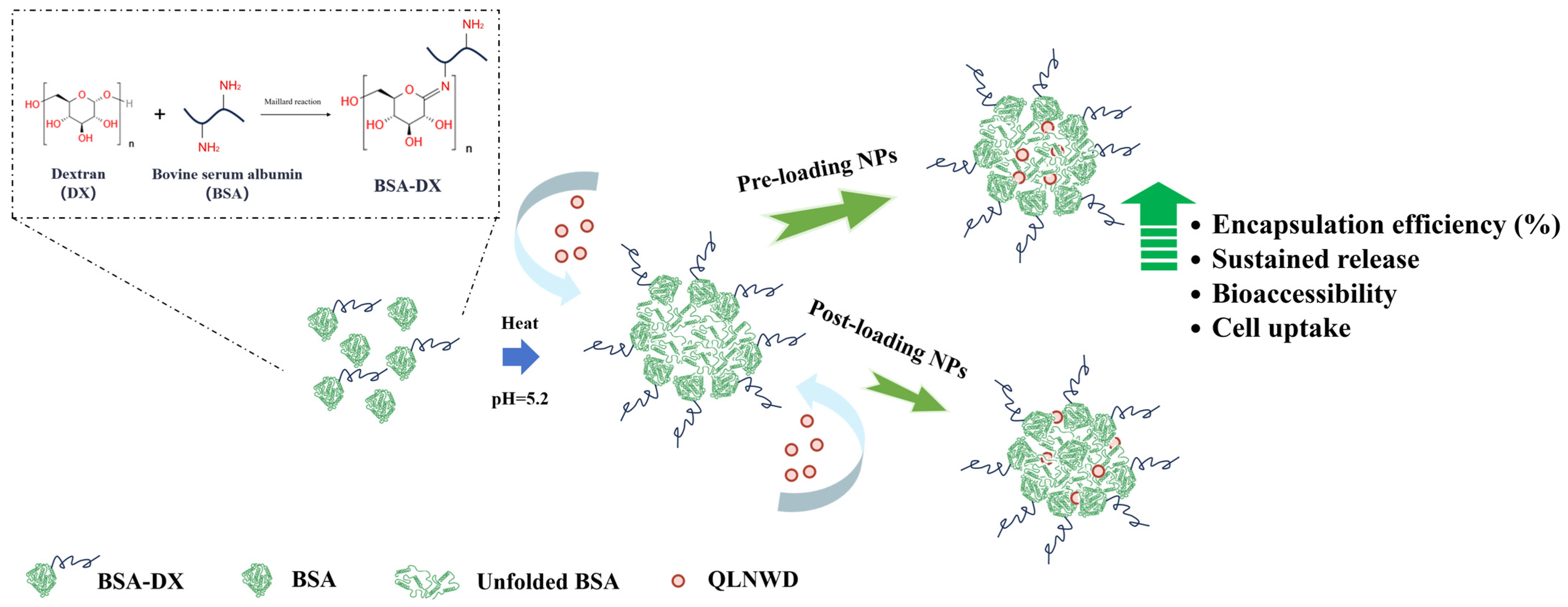
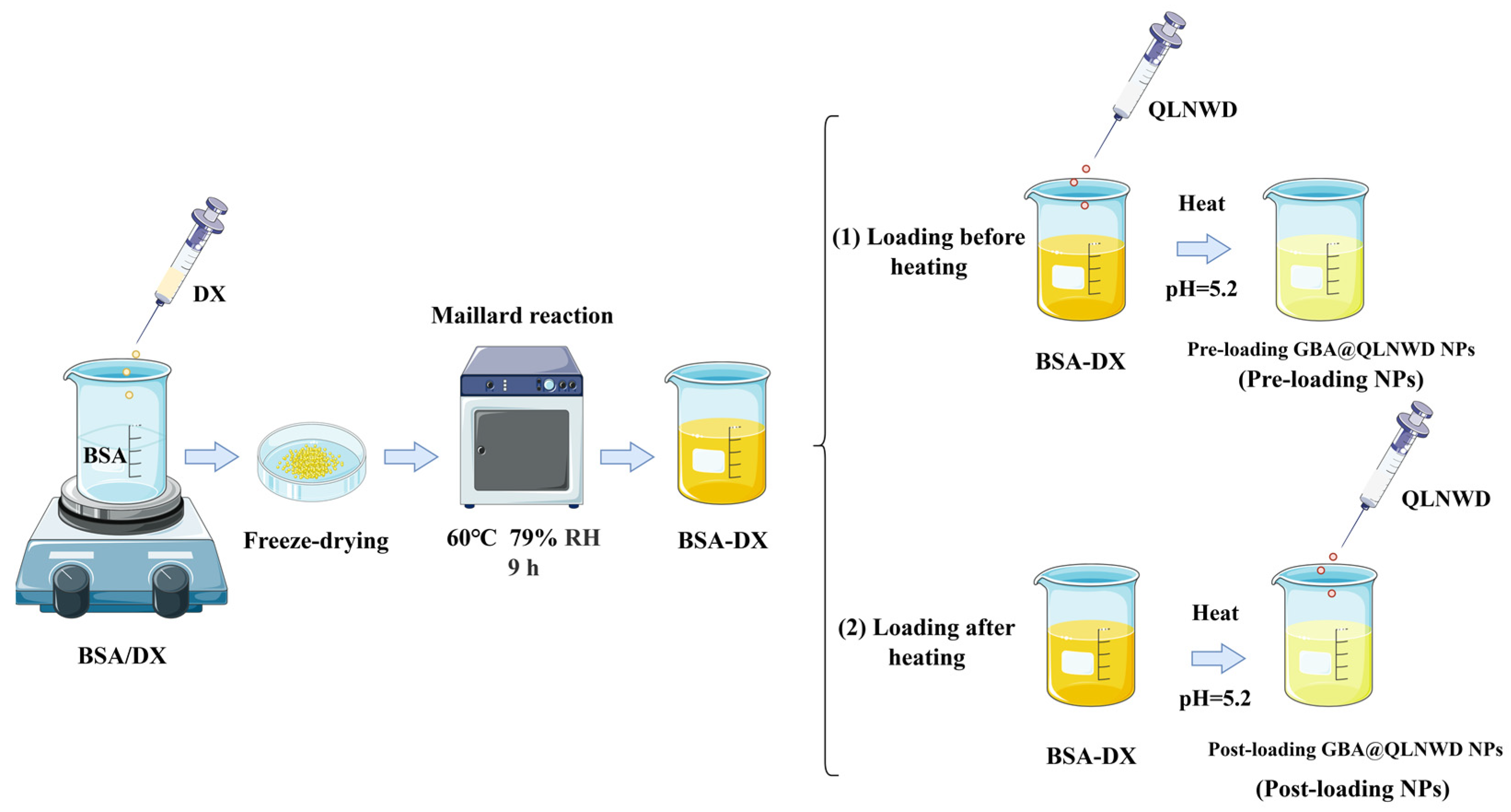
| Sample | Particle Size (nm) | PDI | Zeta Potential (mV) |
|---|---|---|---|
| GBA NPs | 110.84 ± 0.71 a | 0.223 ± 0.011 b | −7.38 ± 0.57 b |
| Pre-loading NPs | 105.51 ± 0.46 b | 0.254 ± 0.010 a | −8.42 ± 0.27 a |
| Post-loading NPs | 94.27 ± 0.27 c | 0.226 ± 0.002 b | −8.12 ± 0.12 ab |
Disclaimer/Publisher’s Note: The statements, opinions and data contained in all publications are solely those of the individual author(s) and contributor(s) and not of MDPI and/or the editor(s). MDPI and/or the editor(s) disclaim responsibility for any injury to people or property resulting from any ideas, methods, instructions or products referred to in the content. |
© 2025 by the authors. Licensee MDPI, Basel, Switzerland. This article is an open access article distributed under the terms and conditions of the Creative Commons Attribution (CC BY) license (https://creativecommons.org/licenses/by/4.0/).
Share and Cite
Wu, W.; Wu, Z.; Cai, J.; Cao, W.; Lin, H.; Gao, J.; Fan, X.; Zheng, H.; Qin, X. A Stable Delivery System for Meretrix meretrix Derived Immunomodulatory Peptide (QLNWD): Fabrication and Characterization of Glycosylated Protein Nanoparticle. Mar. Drugs 2025, 23, 385. https://doi.org/10.3390/md23100385
Wu W, Wu Z, Cai J, Cao W, Lin H, Gao J, Fan X, Zheng H, Qin X. A Stable Delivery System for Meretrix meretrix Derived Immunomodulatory Peptide (QLNWD): Fabrication and Characterization of Glycosylated Protein Nanoparticle. Marine Drugs. 2025; 23(10):385. https://doi.org/10.3390/md23100385
Chicago/Turabian StyleWu, Wanyi, Zhixuan Wu, Jiamin Cai, Wenhong Cao, Haisheng Lin, Jialong Gao, Xiuping Fan, Huina Zheng, and Xiaoming Qin. 2025. "A Stable Delivery System for Meretrix meretrix Derived Immunomodulatory Peptide (QLNWD): Fabrication and Characterization of Glycosylated Protein Nanoparticle" Marine Drugs 23, no. 10: 385. https://doi.org/10.3390/md23100385
APA StyleWu, W., Wu, Z., Cai, J., Cao, W., Lin, H., Gao, J., Fan, X., Zheng, H., & Qin, X. (2025). A Stable Delivery System for Meretrix meretrix Derived Immunomodulatory Peptide (QLNWD): Fabrication and Characterization of Glycosylated Protein Nanoparticle. Marine Drugs, 23(10), 385. https://doi.org/10.3390/md23100385








